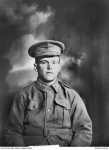DIX, Frank
Frank Dix was 22 years old when he enlisted on 18 January, 1916. He was the son of George Albert Dix and Edith Hooper and identified himself by occupation as a student. He was immediately attached to 'C' Flight, No 1 Squadron of the Australian Flying Corps, at Laverton, Victoria, and appointed as an Air Mechanic. This suggests that his studies were either in engineering or as an airline pilot, as he seems to have received no training at Laverton. He embarked on the HMAT Orsova (A67) on 16 March 1916 and was in England when he declared ill and taken to hospital on 27 August, suffering from lumbago and a slipped disc. He was not discharged to duty until 20 December 1916, but did not return to the Flying Corps. Instead, he was attached to the 42nd Division Headquarters for duty. The initial injury must have been bad, because he never returned to the Australian Flying Corps. Instead, he was placed with the 292 Siege Battery, Royal Garrison Artillery as a wireless operator, in which role he served until the end of the war. Unfortunately, there does not appear to be a surviving war diary for this battery, so it is not possible to know where he served, except that, given by the dates, he served on the Western Front. Apparently the gunners in the various batteries were distributed where they were needed; presumably the same applied to wireless operators.
Frank Dix returned to Australia on board HMAT Port Sydney, disembarking at Melbourne on 17 April, 1919 and was discharged from service on 17 April, 1919. He immediately took up a career as an orchardist. In October, 1922, he applied successfully for a grant under the War Services Homes Act and in 1923, married Dorothea Edna Sadie Cheshire. He died in 1970 at Cambrian Hills, Victoria.
National Archives of Australia Enlistment Record Frank Dix.

